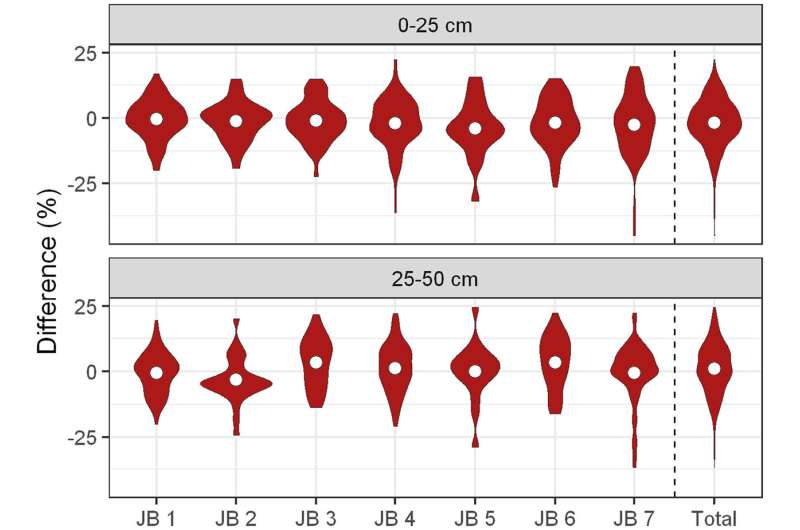This article has been reviewed according to Science X's editorial process and policies. Editors have highlighted the following attributes while ensuring the content's credibility:
fact-checked
trusted source
proofread
Estimating organic carbon stocks of mineral soils in Denmark: Impact of bulk density and content of rock fragments

Soil can store carbon. Therefore, there is also an increasing focus on soil organic carbon content and how to either increase or maintain it. This is because soil can also lose carbon in the form of climate gases from microbial decomposition, in which case soil suddenly contributes to climate change rather than mitigating it. But to maintain or even increase the amount of carbon, farmers need to know the current carbon content of their soil.
Soil contains carbon in the form of organic matter. This is material that comes from plants, such as roots or plant residues such as cover crops that have settled in the soil. It can also come from added organic matter such as manure. The organic matter decomposes in the soil and has an impact on the structure and soil's ability to retain water, for example. It is also the organic matter that sustains soil micro-organisms. Fungi and bacteria break down the material and release nutrients to the plants.
"The soil simply stores carbon and in doing so can help reduce the amount of CO2 in the atmosphere. The soil can also lose carbon through microbial decomposition, and thus the soil contributes to climate change rather than mitigating it," says Ph.D. student Laura Sofie Harbo from the Department of Agroecology at Aarhus University. She explains that it is therefore important to be able to estimate changes in the amount of carbon in the soil, because any increase in the carbon content of the soil can help compensate for other emissions.
"Carbon credits and climate accounting are new concepts that have emerged as climate change becomes more real. Carbon credits is a concept that covers the possibility of being able to buy carbon storage from, for example, a farmer, i.e. where you can buy compensation for your own emissions," explains Laura Sofie Harboe.
Rocks make a difference
Both climate accounts and schemes such as carbon credits require reliable and accurate estimates of the amount of organic carbon in the soil, and of the changes in the soil carbon pool.
"In 1985, the Kvadratnettet was created. It is a nationwide network with a total of 830 measurement points covering about 600 ha of agricultural land. In 1986 and three times since (1997, 2009 and 2019), soil samples have been collected for soil carbon concentration analysis to calculate the amount of carbon per hectare and monitor changes over time in soil carbon content," says Laura Sofie Harbo.
In a new study, she has helped to refine and improve these measurements. There are a number of factors that can complicate soil carbon calculations.
"First of all, it is important to have an accurate and representative measurement of the carbon content of the soil. This is important because carbon can be very unevenly distributed in the soil, so even a small offset in the measurement can cause uncertainties in the estimates," she explains.
Secondly, the new study shows that you need to know the bulk density of the soil as well as the rock content to accurately calculate the carbon content in tons per hectare. This is information that has not previously been used to calculate carbon estimates for Danish farmland, and it makes a big difference.
"When we use this new information on soil bulk density and rock content, the estimates for the amount of organic carbon become more precise," explains Laura Sofie Harbo.
On average, the researchers found that the carbon content measured with the new method was 5% lower than with the previous method, which did not take into account the rocks in the soil.
"Rocks don't contain any organic carbon, so if you don't take them into account, you will always end up overestimating the soil's carbon pool," she says.
Trends take time
"It's important for farmers to get accurate estimates for their land so that they can adjust their operations to either increase or maintain the carbon they already have, so that they don't contribute to additional climate gas emissions," says Laura Sofie Harbo, who explains that an annual inventory of the carbon pool will not be the way forward, even if the new methodology provides more accurate estimates than before.
"It takes time to build up carbon in the soil, which means that the actions we take today won't be measurable tomorrow. In practice, it will be a number of years before the measurements will show a statistically significant trend," she says.
The work is published in the journal Geoderma Regional.
More information: Laura Sofie Harbo et al, Estimating organic carbon stocks of mineral soils in Denmark: Impact of bulk density and content of rock fragments, Geoderma Regional (2022). DOI: 10.1016/j.geodrs.2022.e00560
Provided by Aarhus University



















